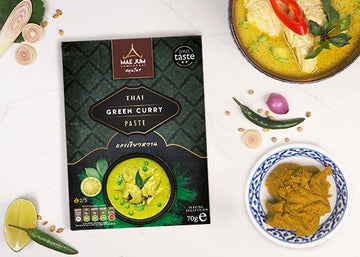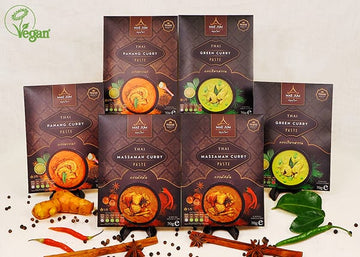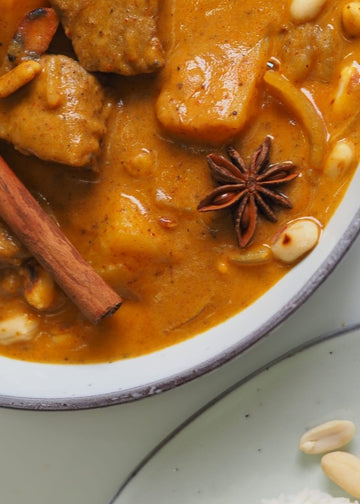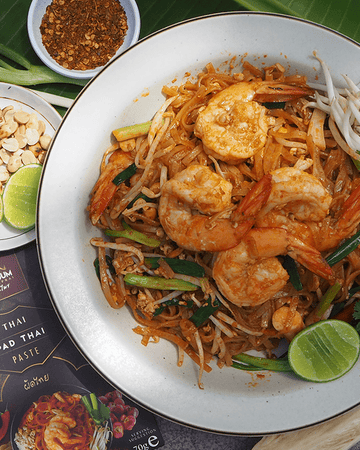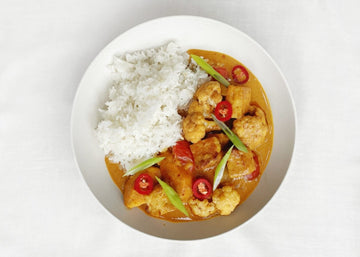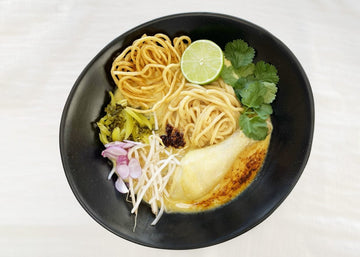A Guide to Cooking Beef Thai Massaman Curry: The Perfect Comfort Food
Beef Thai Massaman Curry is a dish that has become increasingly popular worldwide, celebrated for its rich, mild flavour, and the depth of spices that set it apart from other Thai curries. Its roots are tied to the Islamic heritage in Southern Thailand, giving it a unique cultural twist compared to the more fiery Thai curries such as red or green curry. Massaman curry is a wonderful blend of Thai and Middle Eastern flavours, making it a delicious and memorable meal for any occasion.
What Makes Massaman Curry Special?
Massaman curry is distinct because it incorporates a mix of Thai and Middle Eastern spices, including cinnamon, cloves, cumin, cardamom, and nutmeg. These spices are traditionally used in Middle Eastern and Indian cuisines, but their incorporation into Thai cooking creates a hybrid flavour profile that's mild, warm, and aromatic. Unlike many Thai curries that boast a spicy punch, Massaman curry leans on subtle spices and the richness of coconut milk to create a balanced, comforting dish.
Beef is the most traditional protein used in Massaman curry, but lamb and chicken are also popular alternatives. Some restaurants and home cooks even experiment with pork, although this is rare due to the dish’s Islamic heritage. For vegetarians, Massaman curry can be made using tofu or a variety of vegetables, providing a rich and fulfilling meal without meat.
Another essential ingredient in Massaman curry is potatoes, which help create a hearty, filling dish. The addition of onions and peanuts provides further texture and flavour, while some recipes, such as the one shared here, include tomatoes for a sweet and sour twist. The sweetness from the cherry tomatoes perfectly complements the savoury and rich flavours of the curry, enhancing its overall complexity.
The Origins of Massaman Curry
The word Massaman itself hints at its Islamic influence, deriving from the Thai word "Mussulman," which means "Muslim." The dish was introduced to Thailand by Muslim traders and has since become a staple in Southern Thai cuisine. Unlike other Thai curries, which are more common in the central and northern regions, Massaman curry is typically found in the South, where it has retained its unique blend of flavours and ingredients from the Islamic world.
This curry has evolved over the years, but its heart remains true to its origins. The addition of potatoes and peanuts is thought to have come from Persian traders, while coconut milk and Thai spices were incorporated as the dish made its way through Thailand. Today, Massaman curry is enjoyed both in Thailand and around the world, offering a delightful departure from the spicier Thai curries for those who prefer milder flavours.
Ingredients You’ll Need
Before diving into the cooking process, it’s essential to gather all your ingredients. Here’s what you’ll need for this version of Beef Thai Massaman Curry:
- Beef: A tender cut of beef works best for this recipe. You want something that can cook for a while without becoming tough. Cuts like beef brisket, chuck roast, or stewing beef are ideal as they become more tender as they simmer in the rich curry sauce.
- Potatoes: The starch from the potatoes adds heartiness to the dish, making it more filling and comforting. They also help to absorb some of the curry sauce, ensuring that every bite is packed with flavour.
- Onions: Onions add a natural sweetness to the curry and pair well with the richness of the coconut milk and spices.
- Peanuts: These give the dish a lovely crunch and nutty flavour, providing a great contrast to the creamy curry sauce.
- Cherry Tomatoes: Adding tomatoes is a variation that brings a sweet and slightly sour note to the curry, balancing out the spices. This is an optional addition but highly recommended for added depth.
- Coconut Milk: Coconut milk is crucial for creating the creamy, rich base of the curry. It tempers the spices and gives the dish its luxurious texture.
- Massaman Curry Paste: A high-quality Massaman curry paste is essential for achieving the authentic flavour of this dish. Mae Jum Thai Massaman Curry Paste is an excellent option that delivers the perfect balance of herbs and spices.
- Palm Sugar and Fish Sauce: These two ingredients are essential for balancing the flavours in the dish. Palm sugar adds a subtle sweetness, while fish sauce provides the umami and saltiness that enhances the curry’s complexity.
- Tamarind Paste (optional): Tamarind adds a sour note to the curry, which can enhance the overall flavour profile. It’s not always necessary, but if you enjoy a bit of tanginess, it’s a great addition.
How to Cook Beef Thai Massaman Curry
Now that you’ve gathered your ingredients, it’s time to start cooking! Follow these steps to create a delicious Beef Thai Massaman Curry.
1. Toast the Peanuts
Begin by pan-roasting the peanuts in a dry pan over medium heat. This step intensifies the peanuts’ flavour and gives them a nice golden-brown colour. Be sure to shake the pan frequently to prevent them from burning. Once they’re toasted, remove them from the heat and set them aside in a bowl.
2. Fry the Curry Paste
In a large wok or saucepan, heat a little oil and add the Massaman curry paste. Stir-fry the paste for at least two minutes to release its flavours and aromas. This step is crucial for building the base of your curry. As the curry paste heats, the herbs and spices will begin to break down, creating a fragrant, flavourful foundation for your dish.
3. Add Water and Seasonings
Once the curry paste has fried for a couple of minutes, add about 100ml of water to loosen it. Stir well to incorporate the water, and bring the mixture to a light boil. Add the fish sauce, palm sugar, and tamarind paste (if using), and mix everything together. This creates the balance of sweet, salty, and tangy flavours that are characteristic of a great Massaman curry.
4. Add the Beef and Coconut Milk
Add the beef to the pan, stirring it into the curry paste mixture until it’s well-coated. Next, pour in the coconut milk and bring the curry back to a light boil. Cover the pan and simmer for 30 to 45 minutes, allowing the beef to become tender and absorb the flavours of the curry.
5. Add Vegetables and Peanuts
Once the beef has had time to cook, it’s time to add the potatoes, onions, and toasted peanuts. Pour in another 100ml of water, stir everything together, and let the curry simmer for another 30 minutes. During this time, the potatoes will cook through, and the sauce will thicken to a creamy consistency.
6. Add the Tomatoes
For the final touch, add the cherry tomatoes to the curry. The tomatoes will add a subtle sweetness and sourness to the dish, enhancing the overall flavour. Let the curry simmer for another 10 to 15 minutes, allowing the tomatoes to soften slightly. If the sauce looks too pale, simmer for a bit longer until it develops a richer colour.
7. Serve and Enjoy!
Your Beef Thai Massaman Curry is now ready! Serve it with freshly steamed Thai jasmine rice, which will soak up the delicious, creamy curry sauce. The combination of tender beef, potatoes, onions, and peanuts in the rich Massaman sauce is sure to be a hit with family and friends.
Final Thoughts
Beef Thai Massaman Curry is a fantastic dish that combines the warmth of Middle Eastern spices with the richness of Thai coconut milk. Its mild, sweet, and aromatic flavours make it a great option for those who enjoy complex flavours without the intense heat found in other Thai curries. Whether you’re cooking for a family dinner or a special occasion, this curry is sure to impress. Try adding your own twist by experimenting with different proteins or vegetables, and enjoy the comforting, exotic flavours of Massaman curry.
If you enjoyed our traditional Thai Massaman curry recipe, please give this recipe a star rating and comment if you loved the flavours of this authentic dish! Check out our recipe page for more delicious dishes like this and subscribe for new recipes and posts. Always stay connected and follow us on Instagram and Facebook!
